Overview of the Global Anemia Problem, Including Iron Deficiency Anemia
The World Health Organization (WHO) defines anemia among women of childbearing age as the condition of having a hemoglobin concentration of < 12.0 g/dL at sea level; among pregnant women it is defined as < 11.0 g/dL. The hemoglobin concentration cutoff level that defines anemia varies by age, gender, physiological status, smoking status, and the altitude at which the assessed population lives.
The primary cause of anemia is iron deficiency, a condition caused by inadequate intake or low absorption of iron, the increased demands of repeated pregnancies—particularly if not well spaced (e.g., fewer than 36 months between pregnancies)—and loss of iron through menstruation. Other causes of anemia include vitamin deficiencies (such as a deficiency of folic acid or vitamin A), genetic disorders, malaria, parasitic infections, HIV, tuberculosis, common infections, and other inflammatory conditions. While iron deficiency anemia (IDA) accounts for about onehalf of all anemia cases, it often coexists with these other causes.
Iron deficiency anemia is most common during pregnancy and in infancy, when physiological iron requirements are the highest and the amount of iron absorbed from the diet is not sufficient to meet many individuals’ requirements (Stoltzfus and Dreyfuss 1998). Anemia’s effects include increased risk of premature delivery, increased risk of maternal and child mortality, negative impacts on the cognitive and physical development of children, and reduced physical stamina and productivity of people of all ages (Horton and Ross 2003). Globally, IDA annually contributes to over 100,000 maternal deaths (22 percent of all maternal deaths) and over 600,000 perinatal deaths (Stoltzfus, Mullany, and Black 2004). Key anemia control interventions include promoting a diversified diet, iron-folic acid (IFA) supplementation during pregnancy, iron fortification of staple foods, prevention and treatment of malaria, use of insecticide-treated bed nets, helminth prevention and control, delayed cord clamping, and increased birth spacing.
Maternal Anemia in Indonesia
The prevalence of anemia among pregnant women in Bali, Indonesia is 46 percent, making it a severe public health problem as defined by WHO standards1 (Suega et al. 2002). Regarding anemia severity, the majority of cases among pregnant women are classified as mild (hemoglobin 10.0-10.9 grams/ deciliter). Length of gestation, level of education, and consuming IFA tablets during pregnancy are among the most important risk factors for maternal anemia on the island (Suega et al. 2002). In a study conducted in the Purworejo District of Central Java, now almost two decades old, the prevalence of anemia among pregnant women was highest during the second and third trimesters at 37 and 32 percent, respectively (Nurdiati et al. 2001). Here too, the majority of anemia cases were classified as mild or moderate with less than one percent classified as severe.
Falter Points in Women's Consumption of Iron-Folic Acid During Pregnancy
WHO recommends that all pregnant women receive a standard dose of 30–60 mg iron and 400 μg folic acid beginning as soon as possible during gestation (WHO 2012). Ideally, women should receive iron-containing supplements no later than the first trimester of pregnancy, which means ideally taking 180 tablets before delivery. It is important to note, that many countries aim for women to receive 90 or more tablets during pregnancy.
Figure 1 on the following page shows a decision-tree analysis of how well the Indonesian antenatal care (ANC) system distributes IFA, and identifies four potential points at which the system might falter (highlighted in orange). The figure tracks the number and percentage of women who obtained ANC, those who subsequently received and consumed at least one IFA tablet, and those who consumed the ideal minimum number of tablets.2 All data are based on Indonesia Demographic and Health Survey (IDHS) questions that were asked of women who were in a permanent union and had been pregnant in the five years prior to being interviewed3 (BPS and Macro International 2008).
Figure 1. Analysis of Falter Points Related to Distribution and Consumption of IFA through Indonesia’s ANC Program in 2007, Women of Reproductive Age (15–49 years) n = 32,895
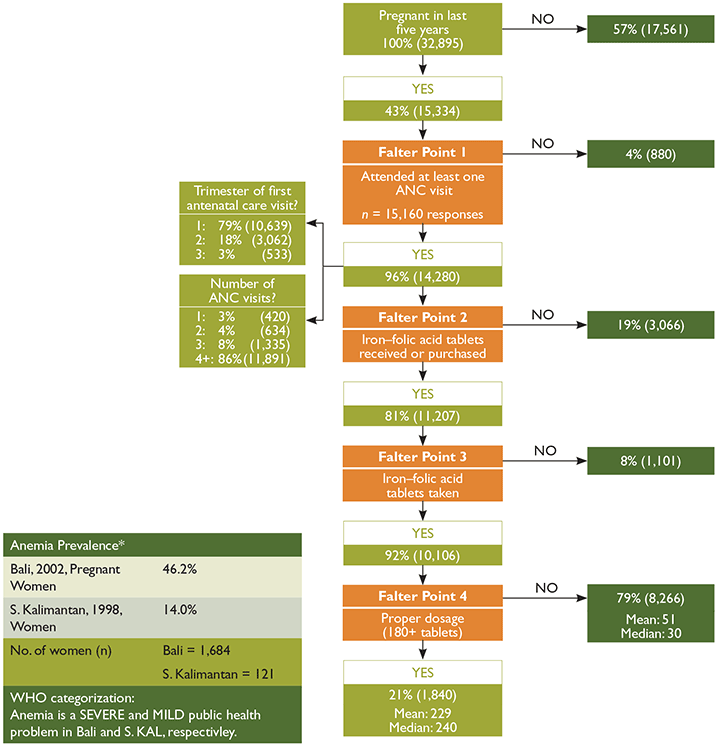
Main Conclusions: Given the high coverage rate, ANC provides an outstanding platform for distributing IFA. Among women who were pregnant in the last five years, had at least one ANC visit, and took at least one IFA tablet, only 21 percent received and took the ideal minimum number of tablets. Falter Points 2 and 4 are the most critical shortcomings within the system, indicating likely supply and demand side constraints.
*Anemia hemoglobin cutoffs: PW Hb<11.0 g/dL; NPW Hb<12.0 g/dL
Non-responses, no data (NR/ND) were recoded to “No” for “At least one ANC visit?”, “IFA tablets received?” and “IFA tablets taken?” and to zero for “Number of tablets taken?”
Anemia prevalence data are provided as a reference point, signaling the general order of magnitude of the anemia public health problem. The ANC utilization data is based on self-reported data of women 15–49 years in permanent unions and pertains to their last pregnancy in the last five years prior to the DHS survey.
Source: Calculations are from the Indonesia Demographic and Health Survey (2007). Anemia levels for Bali are from WHO VMNIS, Reference: 4055, 2002 and South Kalimantan from WHO VMNIS, Reference: 2484, 1998
Many supply-side aspects—including both adequacy of IFA tablet supplies and technical knowledge and practices of ANC providers—need to be considered when assessing how well an ANC program delivers IFA. In addition, Falter Point 4 in Figure 1 clearly shows that the provision of IFA tablets to a pregnant woman is a necessary but not sufficient condition for the woman to consume the tablets, particularly at the ideal minimum. Thus, demand-side factors also play a critical role in determining the coverage and effectiveness of this program. These include whether or not women seek antenatal care and the timing and number of visits, as well as the extent to which women are aware of the significance of anemia and IFA, ask for IFA tablets, and comply with the IFA regimen.
Understanding the relative significance of each falter point enables them to be prioritized for more in-depth analysis, providing a first step in an evidence-based approach to systematically improving the program. The DHS does not collect information on the number of IFA tablets received by women. In the case of Falter Point 4, this lack of data creates ambiguities that make it impossible to fully understand whether shortcomings of the system relate primarily to supply- or to demand-side factors. Despite this limitation, the decision-tree analysis presented in Figure 1 still enables prioritizing the falter points for more in-depth analysis and action at the national, district, and health center levels.
Analysis of Falter Points
Falter Point 1:
Did not attend at least one ANC visit
Only four percent of women did not obtain at least one ANC visit. ANC’s high coverage gives it great potential as a vehicle for providing IFA coverage.
Falter Point 2:
Did not receive or purchase at least one IFA tablet
Of the women with at least one ANC visit, 19 percent did not receive or purchase any IFA.
This supply-side constraint is relatively large when compared with other countries and may be due to various system/supply-side performance shortcomings which could reflect: (1) Inadequate supply (e.g., stock outs); (2) Provider knowledge; (3) Provider practices that may have failed to provide IFA. As Figure 2 shows, this is the second most important falter point among all pregnant women in Indonesia.
Unfortunately, the IDHS does not report the source(s) of the IFA tablets women received or purchased, and there is a small percentage of women attending ANC who get IFA tablets from a different source. While less than one percent of Indonesian women who received or purchased IFA did not have any ANC visits (not shown), we cannot ascertain whether or not those who received ANC care obtained their IFA from their ANC provider. It is likely, however, that women who attend ANC are more likely to be aware of, to value and to be inclined to also take IFA, regardless of where they obtain them. Thus we would expect there to be a high correlation between the number of women who had at least one ANC visit and those who received or purchased IFA, which is consistent with the data. Women who have one or more ANC visits and who did not receive any IFA, constitute a missed opportunity to reduce the risk of anemia among a high-risk population.
Falter Point 3:
Did not take at least one IFA tablet
Of the women who received IFA, eight percent did not consume any tablets
This demand-side constraint is relatively small and may be due to women not understanding the significance of anemia and/or the significance of IFA. This misunderstanding may reflect: (1) inadequate provider counseling and follow-up; (2) women’s beliefs about actual or possible side-effects; or (3) sociocultural factors.
Falter Point 4:
Did not consume 180 or more IFA tablets
Of the women who received and took IFA, 79 percent did not consume the ideal minimum of 180 IFA tablets.
This is a combination of supply and/or demand-side factors. Figure 1 sheds some light on two possible causes of this falter point: 21 percent of women who received ANC began their care after the first trimester, and the 15 percent who had less than WHO’s recommended four ANC visits during their last pregnancy may have started their ANC too late or may not have had enough visits to receive 180 tablets (given IFA distribution protocols). Both of these are likely contributing factors, but further research is needed to establish their relative importance, as well as the significance of other possible causes. It is noteworthy, however, that the percent of women starting ANC in the first trimester and the average number of visits received are both very high by international standards.
Globally, research has found that other common causes of Falter Point 4 include: (1) providers do not have access to adequate supply; (2) women do not receive adequate tablets because they have little access to care, or start ANC late, or do not have enough ANC visits making it difficult to obtain 180 tablets (given IFA distribution protocols); (3) providers do not provide adequate counseling or follow-up; (4) women do not adhere to the regimen; which may be due to difficulty in remembering to take the tablets daily, not knowing all the tablets are necessary, fear of having a big baby, side effects, tablet-related issues (taste, size, color, coating, packaging/storage problem). Further research is needed to determine the specific reasons for this falter point in Indonesia.
Analysis by Sociodemographic Variables and Trends over Time
A comparison of 2002–2003 and 2007 IDHS data reveals that both ANC and IFA coverage in Indonesia have been relatively stagnant over the five year period, increasing from 95 to 96 percent and decreasing from 78 to 77 percent, respectively. Amongst subgroups of women, it is the mother’s education level that shows the greatest disparities in coverage (see Table 1). Only 74 percent of mothers with no education in 2007 received ANC compared to 99 percent percent of mothers with secondary education or higher. Equally marked variations are seen in IFA coverage rates (defined as the percentage of women, among all women who were pregnant in the past five years, who received and took at least one IFA tablet). Eighty-eight percent of mothers with secondary education or higher received IFA tablets during their pregnancy compared with only 42 percent of mothers with no education. The largest reductions in coverage were also seen among mothers with no education. As seen in the bottom of Table 1, differences in coverage rates by residence are relatively small: urban women are more likely to have received IFA or ANC than their rural counterparts by twelve and five percentage points, respectively, with rates improving little between 2002-2003 and 2007. These levels and trends in education and residence suggest that improving ANC access and ensuring that providers are adequately counseling their patients to increase awareness of the benefits of IFA supplementation are essential to reducing inequalities.
Table 1. Changes in ANC and IFA Coverage in Indonesia Among Women 15–49 who had a Live Birth in the Past Five Years, 2002/03 and 2007 IDHS
| Characteristic | ANC Coverage | Change in Coverage | Took 1 + IFA Tablet | Change in Coverage | ||
|---|---|---|---|---|---|---|
| 2002/03 | 2007 | 2002/03 | 2007 | |||
| Education | ||||||
| Residence Area | ||||||
| No Education | 82.1% | 74.0% | -8.1% | 50.4% | 42.3% | -8.1% |
| Some Primary | 89.2% | 90.0% | 0.8% | 64.5% | 60.6% | -3.9% |
| Complete Primary | 95.5% | 95.0% | -0.5% | 77.5% | 73.3% | -4.2% |
| Some Secondary | 97.4% | 97.9% | 0.5% | 81.9% | 81.9% | 0.0% |
| Secondary + | 99.3% | 99.5% | 0.2% | 89.3% | 87.9% | -1.4% |
| Urban | 97.6% | 98.6% | 1.0% | 82.8% | 84.0% | 1.2% |
| Rural | 93.5% | 93.9% | 0.4% | 74.5% | 72.5% | -2.0% |
| National Average | 95.4% | 95.8% | 0.4% | 78.4% | 77.3% | -1.1% |
Table 2 disaggregates current ANC and IFA coverage rates by geographical unit (major islands or island groups) and wealth. Only two geographical units, Java and Nusa Tenggara, have IFA coverage rates above that of the national average. Papua has both the lowest ANC and IFA coverage at 75 and 58 percent, substantially lower than the national averages of 96 and 77 percent. A clear and direct relationship to wealth quintile is evident with ANC coverage and the percentage of pregnant women taking IFA. Based on the presented information, Maluku and Papua along with those in the lower wealth quintiles should be targeted for efforts to improve their ANC and IFA coverage.
Table 2. ANC and IFA Coverage During Last Pregnancy in the Last Five Years by Geographical Unit and Wealth Indonesia, 2007
| Characteristic | No. Women with a Live Birth - Last 5 Years | Received ANC | Took 1 + IFA Tablet | ||
|---|---|---|---|---|---|
| Number | Percentage | Number | Percentage | ||
| Geographical Unit | |||||
| Wealth | |||||
| Sumatera | 2,890 | 2,731 | 94.5% | 2,010 | 69.6% |
| Java | 7,811 | 7,601 | 97.3% | 6,353 | 81.3% |
| Nusa Tenggara | 947 | 895 | 94.5% | 825 | 87.1% |
| Kalimantan | 917 | 869 | 94.8% | 636 | 69.4% |
| Sulawesi | 1,145 | 1,087 | 94.9% | 827 | 72.2% |
| Maluku | 170 | 153 | 90.0% | 116 | 68.2% |
| Papua | 162 | 122 | 75.3% | 95 | 58.6% |
| Lowest | 3,010 | 2,665 | 88.5% | 1,863 | 61.9% |
| Second | 2,791 | 2,658 | 95.2% | 2,035 | 72.9% |
| Middle | 2,812 | 2,737 | 97.3% | 2,297 | 81.7% |
| Fourth | 2,742 | 2,722 | 99.3% | 2,353 | 85.8% |
| Highest | 2,688 | 2,676 | 99.6% | 2,314 | 86.1% |
| National Average | 14,043 | 13,458 | 95.8% | 10,862 | 77.3% |
In Figure 2, we see that the number of days women took IFA tablets during pregnancy has made little progress. The percentage of women who did not take any IFA tablets during their most recent pregnancy increased slightly, while those taking 90 or more remained the same. Less than a third of pregnant women reported receiving the Ministry of Health’s recommended number of IFA tablets, just half of ideal minimum of 180. Though government iron supplementation programs are to provide all pregnant women IFA tablets, the amount of tablets purchased for distribution in the past has only been sufficient to cover 60 percent of pregnant women (Kodyat, Kosen, and de Pee 1998; Galloway et al. 2002). If unable to obtain IFA tablets from other sources, the high percentage of women who are not receiving IFA supplementation through ANC visitations, as seen in Falter Point 2 in Figure 1, may be a reflection of this shortage.
Figure 2. Number of IFA Tablets Received and Taken by Women During Pregnancy Indonesia, 2002/2003–2007
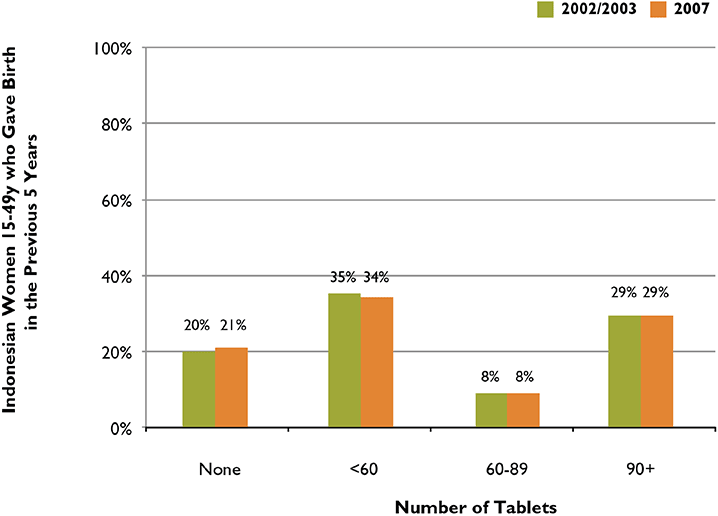
Analysis by Geographic Region
The map in Figure 3 shows how the percentage of women with at least one ANC visit who received at least one IFA tablet varies by region. Coverage rates differ from 59 to 69 percent in many of the northwestern provinces to 87 to 95 percent in the southern islands and North Sulawesi and North Maluku. Overall, coverage rates are moderate when compared with other low- and middle-income countries, and targeting regions with the lowest coverage rates may be warranted for improving IFA coverage through ANC. Given the high ANC coverage throughout the country, expanding IFA coverage through ANC may take advantage of the missed opportunity to get more women to achieve a minimum of 180 tablets during their pregnancy.
Figure 3. Percentage of Women Who Had at Least One ANC Visit and Received at Least One IFA Tablet by Region, Indonesia, 2007
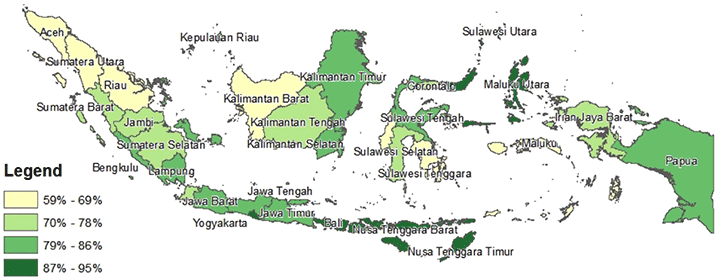
Analysis by Number of ANC Visits
Figure 4 shows the relationship between the number of IFA tablets taken by women who had at least one ANC visit, and the number of ANC visits they had during their last pregnancy. Fifty-nine percent of the women who had at least one ANC visit took at most one-quarter (45) of the ideal minimum number of IFAs. While women with more visits were generally likely to receive and take more IFA tablets, the relationship is weak. Only 19 percent of women with 4 or more ANC visits received 180 or more IFA tablets. Learning what accounts for this ceiling is a critical challenge to improving the effectiveness of the ANC-based distribution of IFA in Indonesia. One explanation may be the recommendation of IFA supplementation for 90 days during pregnancy by the Ministry of Health. However, less than a third of women are currently meeting this lower national benchmark.
Figure 4. ANC Distribution of IFA Tablets: Number of Tablets Received and Taken According to Number of ANC Visits, Indonesia, 2007
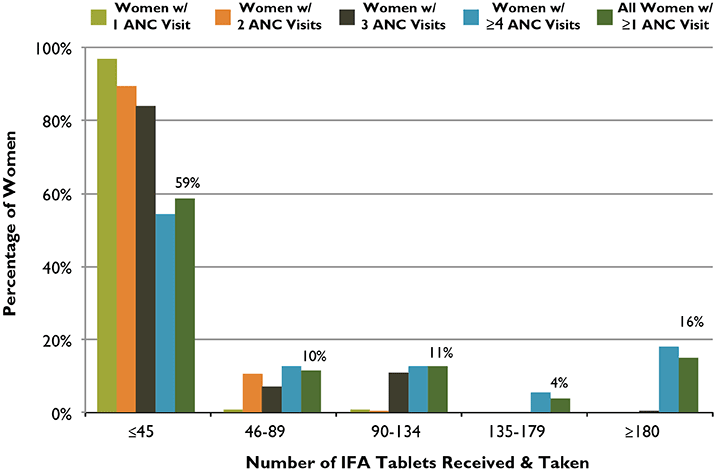
Overall Conclusions and Recommendations
Figure 5 presents the obstacles amongst all women, including those who did not receive ANC during their pregnancy, to taking the ideal minimum number of IFA tablets. In Indonesia, Falter Points 2 and 4 are the greatest barriers. Improving the delivery of IFA supplementation to Indonesia will therefore rely heavily on identifying and addressing program gaps in IFA supply management and health workers’ practices. Modifying some women’s long term adherence behaviors, and addressing other points mentioned above, under Analysis of Falter Points, may also lead to more women taking a minimum of 180 tablets (addressing Falter Point 4).
Figure 5. The Relative Importance of Each of the Falter Points in Indonesia: Why Women Who Were Pregnant in the Last Five Years Failed to Take the Ideal Minimum of 180 IFA Tablets
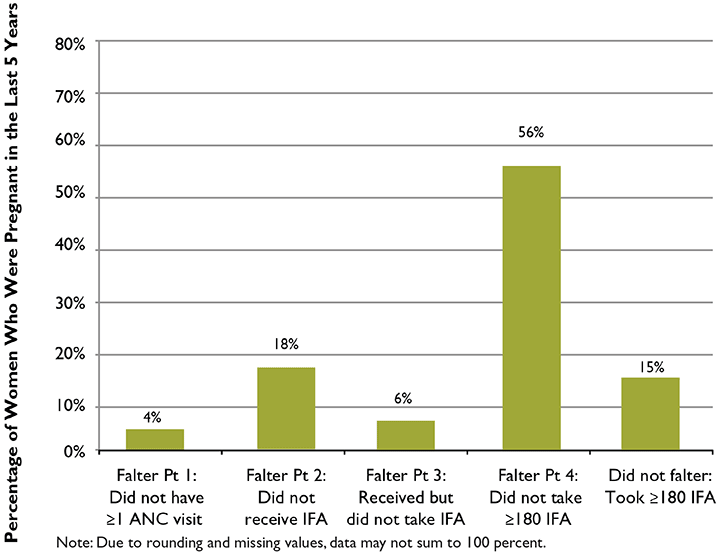
Receiving quality ANC is essential to achieving the fifth Millennium Development Goal (MDG 5) of improving maternal health. Indonesia has the 51st highest maternal mortality rate (MMR) in the world at 220 maternal deaths per 100,000 live births. The country is currently not on track to meet its target of reducing the MMR to 102 or lower in 2015, (MNDP 2012) and as this rapid assessment of the distribution of IFA tablets through ANC suggests, there is substantial room for improving both the supply- and the demand-sides of Indonesia’s ANC program. Focusing on Falter Points 2 and 4 and improving the distribution of IFA and the average number of tablets taken could help improve Indonesia’s chances of meeting its MDG5 targets and reduce the prevalence of anemia. The majority of Indonesian women (79 percent) receive their ANC from nurses, midwives or village midwives, suggesting that efforts to improve outreach and quality of care by these providers, particularly to the uneducated and poor, could improve IFA coverage. Improving the distribution of IFA through the ANC program is an important strategy to prevent and control anemia in Indonesia, and to improve the nutrition and health status, as well as the mental and physical capacity of women of reproductive age.
Footnotes
1 The WHO categorizes the severity of anemia as a public health problem according to its prevalence: <5%, no public health problem; 5–19.9%, mild; 20–39.9% moderate; ≥40%, severe.
2 The IDHS asked about IFA tablets or capsules; this brief refers to all types as “tablets”.
3 The IDHS provides a population-based, nationally representative sample of all women in Indonesia.
References
Galloway, Rae, Erin Dusch, Leslie Elder, Endang Achadi, Ruben Grajeda, Elena Hurtado, Mike Favin, Shubhada Kanani, Julie Marsaban, Nicolas Meda, K. Mona Moore, Linda Morison, Neena Raina, Jolly Rajaratnam, Javier Rodriquez, and Chitra Stephen. 2002. “Women’s Perceptions of Iron Deficiency and Anemia Prevention and Control in Eight Developing Countries.” Social Science and Medicine 55:529–44.
Galloway, Rae. 2003. Anemia Prevention and Control: What Works. Washington, DC: USAID.
Horton, Sue and Jay Ross. 2003. “The Economics of Iron Deficiency.” Food Policy 28(1):51-75.
Kodyat, Benny, Soewarta Kosen, and Saskia de Pee. 1998. “Iron Deficiency in Indonesia: Current Situation and Intervention. Nutrition Research 18(12): 1953-1963.
Ministry of National Development Planning (MNDP). 2012. Report on the Achievement of Millennium Development Goals in Indonesia 2011. Jakarta, Indonesia: MNDP.
Nurdiati, Detty Siti, Sri Sumarni, Suyoko, Mohammad Hakimi, and Anna Winkvist. 2001. “Impact of Intestinal Helminth Infection on Anemia and Iron Status During Pregnancy: A Community Based Study in Indonesia.” Southeast Asian Journal of Tropical Medicine Public Health 32(1): 14-22.
Sari, Mayang, Saskia de Pee, Elviyanti Martini, Susilowati Herman, Sugiatmi, Martin W. Bloem MW, and Ray Yip. 2001. “Estimating the Prevalence of Anaemia: A Comparison of Three Methods.” Bulletin of the World Health Organization 79(6):506-511.
Statistics Indonesia (Badan Pusat Statistik – BPS) and ORC Macro. 2003. Indonesia Demographic and Health Survey 2002-2003. Calverton, Maryland: BPS and ORC Macro.
Statistics Indonesia (Badan Pusat Statistik – BPS) and Macro International. 2008. Indonesia Demographic and Health Survey 2007. Calverton, Maryland: BPS and Macro International.
Stoltzfus, Rebecca J., and Michele L. Dreyfuss. 1998. Guidelines for the Use of Iron Supplements to Prevent and Treat Iron Deficiency Anemia. Washington, DC: ILSI Press.
Stoltzfus, Rebecca J., Luke Mullany, and Robert E. Black. 2004. “Iron Deficiency Anemia.” In Comparative Quantification of Health Risks: Global and Regional Burden of Disease Attributable to Selected Major Risk Factors, edited by Majid Ezzati, Alan D. Lopez, Anthony Rodgers, and Christopher J. L. Murray, 163-209. Geneva, Switzerland: World Health Organization.
Suega, Ketut, Tjok Gde Dharmayuda, I Made Sutarga, and I Made Bakta. 2002. “Iron-deficiency Anemia in Pregnant Women in Bali, Indonesia: A Profile of Risk Factors and Epidemiology.” Southeast Asian Journal of Tropical Medicine and Public Health 33(3):604-607.
World Health Organization (WHO). 2012. “Guideline: Daily Iron and Folic Acid Supplementation in Pregnant Women.” Geneva: WHO.